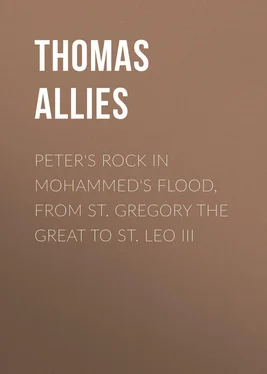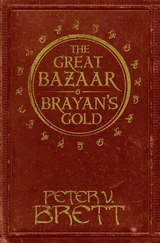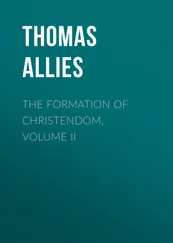Thomas Allies - Peter's Rock in Mohammed's Flood, from St. Gregory the Great to St. Leo III
Здесь есть возможность читать онлайн «Thomas Allies - Peter's Rock in Mohammed's Flood, from St. Gregory the Great to St. Leo III» — ознакомительный отрывок электронной книги совершенно бесплатно, а после прочтения отрывка купить полную версию. В некоторых случаях можно слушать аудио, скачать через торрент в формате fb2 и присутствует краткое содержание. Издательство: Иностранный паблик, Жанр: foreign_antique, foreign_prose, Историческая проза, на английском языке. Описание произведения, (предисловие) а так же отзывы посетителей доступны на портале библиотеки ЛибКат.
- Название:Peter's Rock in Mohammed's Flood, from St. Gregory the Great to St. Leo III
- Автор:
- Издательство:Иностранный паблик
- Жанр:
- Год:неизвестен
- ISBN:нет данных
- Рейтинг книги:4 / 5. Голосов: 1
-
Избранное:Добавить в избранное
- Отзывы:
-
Ваша оценка:
- 80
- 1
- 2
- 3
- 4
- 5
Peter's Rock in Mohammed's Flood, from St. Gregory the Great to St. Leo III: краткое содержание, описание и аннотация
Предлагаем к чтению аннотацию, описание, краткое содержание или предисловие (зависит от того, что написал сам автор книги «Peter's Rock in Mohammed's Flood, from St. Gregory the Great to St. Leo III»). Если вы не нашли необходимую информацию о книге — напишите в комментариях, мы постараемся отыскать её.
Peter's Rock in Mohammed's Flood, from St. Gregory the Great to St. Leo III — читать онлайн ознакомительный отрывок
Ниже представлен текст книги, разбитый по страницам. Система сохранения места последней прочитанной страницы, позволяет с удобством читать онлайн бесплатно книгу «Peter's Rock in Mohammed's Flood, from St. Gregory the Great to St. Leo III», без необходимости каждый раз заново искать на чём Вы остановились. Поставьте закладку, и сможете в любой момент перейти на страницу, на которой закончили чтение.
Интервал:
Закладка:
Returning to the history of this time we find that the successor of Pope Severinus, John IV., was consecrated 24th December, 640, and held a council at Rome immediately after his accession, and condemned under anathema the Monothelite heresy. Heraclius died February 11th, 641. Upon his death Pope John IV. sent a letter to his successors, Constantinus-Heraclius, and Heracleonas, setting forth the same faith. He also informed the new Patriarch, Pyrrhus, that he had condemned the Ecthesis: and St. Maximus informs us that Heraclius I., to turn away the Western displeasure at the Ecthesis from his own person, at the beginning of the year 641 wrote to Pope John IV. that “the Ecthesis is not mine, nor did I command it to be drawn up, but the patriarch Sergius prepared it five years ago, and besought me on my return from the East to publish it with my subscription”. The purpose of John IV. in writing to the new emperors was to set forth the doctrine of the two Operations and Wills in Christ, and in doing this to defend the orthodoxy of his predecessor Honorius. It is to be observed that after the death of Honorius, when the eastern patriarchs began to assert that Honorius in his answers to Sergius, which up to that time had been private, favoured the heresy which Sergius had imposed upon the eastern bishops, and was trying to put upon the Pope, his successors denied with much care that Honorius had any such meaning. Thus in this document of Pope John IV. directed to the sons of Heraclius, which bears the title, Defence of Pope Honorius, he says: —
“My predecessor, teaching concerning the mystery of Christ's Incarnation, said that there were not in Him, as there are in us, opposing wills of the spirit and the flesh. Certain men, twisting this to their own meaning, threw out the suspicion that he had taught that there was one Will of the Godhead and the Manhood, which is utterly contrary to the truth. I could wish them to reply to my question, in regard to which nature do they assert that there is one Will of Christ our God? If it be only in regard to the Divine Nature, what is their reply concerning His Human Nature? For he is likewise Perfect Man, lest they be condemned with Manichæus. If they speak in regard to the Manhood of Christ that this Will is Perfect God, let them see whether they do not fall under the condemnation of Photinus and Ebion. But if they assert that in the Two Natures there is only one Will, they will confuse not only the Natural Wills but the Natures themselves, so that neither the one nor the other, that is, the Divine and the Human, can be understood. For as we do not, like the impious Nestorius, suffer Two Natures to make up one Christ, so we do anything but deny, yet neither do we confuse, the difference of Natures, inasmuch as we confess the Two Natures united in the one Person of Christ our God with an agreement which language is not able to express. For in that they assert One Will of Christ's Godhead and Manhood and at the same time one Operation, what else do they assert than that one Nature of Christ our God operates according to the division of Eutyches and Severus. As a last argument, the orthodox Fathers, who have flourished in the whole world, are proved to teach in full accordance at once Two Natures and Two Wills and Operations.”
In these words, which John IV. writes as Pope to the immediate successors of Heraclius within three years after the death of Honorius, he would seem not only to have set forth in plain language the immense importance of the doctrine itself, but to be an unimpeachable witness of the meaning of Honorius, one of whose priests he had been, and as such well acquainted with his doctrine.
The pontificate of John IV., for the confirmation of which he had to wait four months, lasted only twenty-one months, and was disquieted throughout by the conflict with the Byzantine court and patriarch respecting the Ecthesis. There was war between the exarch and the Lombard king, Rotharis, but it did not touch Rome. All misfortunes which threatened it came from Byzantium. The struggle against the eastern heresy embittered the feeling of Constantinople to Rome. At the same time, the Byzantine court was disturbed by intestine revolutions. Heraclius ended his reign of 31 years in February, 641. His eldest son, Heraclius Constantinus, succeeded, but, after seven months, was poisoned by his stepmother, Martina, and the Monothelite patriarch Pyrrhus was charged with concurrence. In a few months, Martina's own son, Heracleonas, was deposed by an insurrection. His nose was cut off, and the tongue of the empress Martina cut out, and both were banished. The grandson of Heraclius, Constans II., became emperor in 642, a boy of twelve years, and reigned 26 years, until 668. The reign of this emperor is much to be noted, because it is contemporaneous with the second, third, and fourth chalifs: Constans II. stands in history over against Omar, Osman, and Ali.
On the death of John IV., Theodorus, a Greek of Jerusalem, was made Pope: it is supposed by the influence of the exarch Isaac. He was the first of many Greeks, who, in this period, were made Popes: of all of whom, without exception, it is recorded that their integrity, as Popes, was in no way affected by any national feeling: they sacrificed nothing to Byzantine policy.
At the beginning of this pontificate, Mauritius, the officer called chartular, whose proceeding in the robbery of the Lateran treasury has been recorded above, raised a rebellion in Rome. He found people, nobility, and army embittered by the Byzantine domination, and used this feeling for his own purposes. He spread a report that Isaac was striving to be king, made party with those same turbulent Romans who had joined in the attack upon the Lateran, and induced the garrisons in all the castles of the Roman territory to refuse obedience to the exarch. When Isaac heard this, that all the army of Italy had taken the oath to Mauritius, he sent Donus as commander with an army to Rome. Thereupon the Roman army gave up Mauritius, and joined Donus. Mauritius took asylum at St. Mary of the Crib. He was taken out and sent with an iron collar about his neck, as well as the others implicated in the insurrection, to the exarch at Ravenna: but, before he arrived there, was beheaded, and his head carried to Ravenna and impaled. Isaac kept the other conspirators in prison, collared in the same way, but they escaped execution by the death of Isaac himself. Isaac was buried in the beautiful church of St. Vitale, in Ravenna, and his epitaph is preserved in Greek, and being a picture not only of the man, but of his time, is worth transcribing. It runs thus: —
“Here lies one, a brilliant commander, who for six years, preserved Rome and the West without injury for our serene lords, Isaac, the fellow-worker with emperors, the great ornament of all Armenia, where he was of illustrious race. Upon his death in great renown, his wife Susannah mourns over her loss like a chaste dove, the loss of a husband who gained glory by his labours both in the East and in the West, for he commanded the army of both.”
Isaac may be considered as the ideal exarch, and by contemplating his deeds, we may attain to a knowledge of the race of exarchs, viceroys of Italy, and images, in common clay, of their masters in marble, towards whom, for 200 years, St. Gregory and his successors had to exercise the virtue of loyalty.
Upon the accession of Constans II., in 642, the patriarch Pyrrhus, under suspicion of complicity with the empress Martina in the poisoning of the emperor Heraclius Constantinus, fled to Africa. His place was taken by Paulus, a still more zealous Monothelite. Pyrrhus, coming to the West, which was unanimous in rejecting that heresy, represented himself to have been convinced by the eloquence of the Abbot Maximus, in an African Council in 645, and came to Rome to lay the confession of his faith at the feet of the Apostle Peter. Pope Theodorus received the repentant patriarch with great ceremony in the Vatican Basilica before the assembled clergy and people, to whom he solemnly condemned his own errors. But, when he went to Ravenna, Pyrrhus fell back again. Pope Theodorus thereupon condemned him in a Roman Council.
Читать дальшеИнтервал:
Закладка:
Похожие книги на «Peter's Rock in Mohammed's Flood, from St. Gregory the Great to St. Leo III»
Представляем Вашему вниманию похожие книги на «Peter's Rock in Mohammed's Flood, from St. Gregory the Great to St. Leo III» списком для выбора. Мы отобрали схожую по названию и смыслу литературу в надежде предоставить читателям больше вариантов отыскать новые, интересные, ещё непрочитанные произведения.
Обсуждение, отзывы о книге «Peter's Rock in Mohammed's Flood, from St. Gregory the Great to St. Leo III» и просто собственные мнения читателей. Оставьте ваши комментарии, напишите, что Вы думаете о произведении, его смысле или главных героях. Укажите что конкретно понравилось, а что нет, и почему Вы так считаете.












